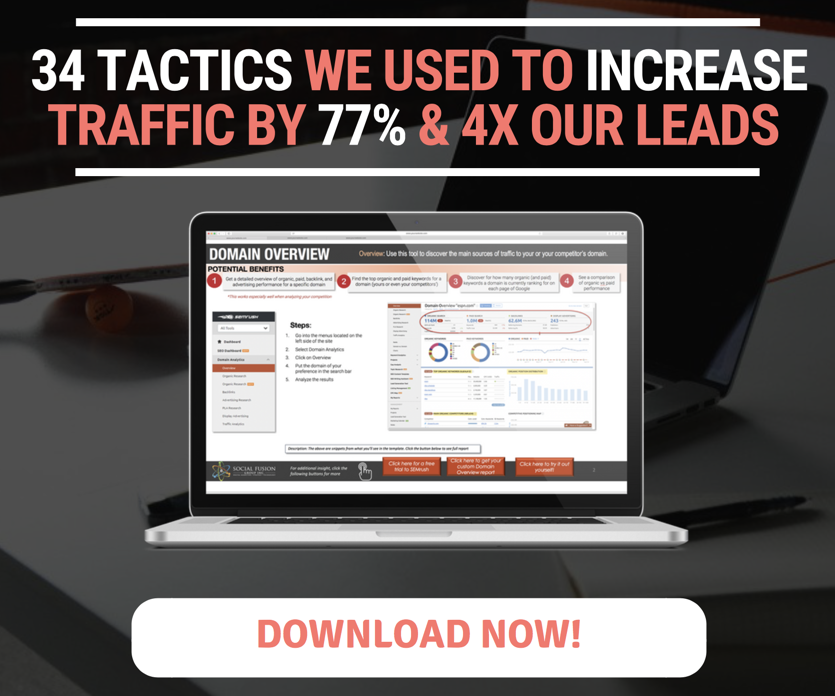This post has been updated for May, 2019
Search engine optimization (SEO) is a scary term for some. Businesses create great content, only to get minimal results. SEO doesn't have to be hard, or scary; if implemented correctly, SEO can be your best friend. For those unaware, Search Engine Land defines SEO as, “...the process of getting traffic from the ‘free’, ‘organic’ ‘editorial’, or ‘natural’ search results on search engines.”

The purpose of implementing an SEO strategy is to get your website and content to rank on Google and other search engines. The earlier this is done, the more traffic you can potentially get (which ultimately can lead to more conversions, and greater brand awareness for your business and content.) To get a grip about the latest in the SEO and follow a good strategy read this handy guide about SEO Strategy for 2019.
"Successful SEO is not about tricking Google. It’s about PARTNERING with Google to provide the best search results for Google’s users." - Main Street ROI
Now you might be thinking, "I already know all this, why should I continue reading?" Because SEO trends are evolving, and most importantly, search engine algorithms are getting more sophisticated. This means that there a few changes that need to be made in the way you carry out your SEO tactics in 2019.
Focus on User Intent: Writing for Crawlers is a Thing of the Past
What was the one thing we were all taught when we were SEO rookies? If you want to rank, you need to start modeling your content for search engines. All the top ranking content creators and SEO marketers were carefully and strategically placing keywords while performing a whole bunch of back-end optimization, to rank high on Google’s SERPs. Now this worked for a long time (and amazingly,) but not anymore…
SEO has been changing for quite some time now, and during late 2017, early 2018 this change had only accelerated. Search engines continue to get more sophisticated shifting toward “user intent” (aka actually creating content for humans and not web crawlers.)
Take yourself for instance, when you type something of interest in Google; let’s say “how to bake a chocolate cake," you may not care about bakeries selling the pastry, songs containing that phrase, menu items, children’s shows etc. but this is not clear to Google.
All you may care about is how to make that specific type of cake. So what is Google to do? How can it understand what it is you are truly searching for so it can provide the best results?
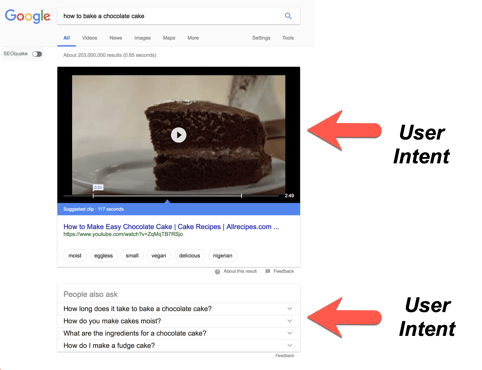
Well, in plain terms, it tries to figure out what content is about, the same way you would.
Search engine algorithms today are designed to search for, and gauge the relevant results in the same way humans would. This is so search engines can provide the most relevant content to your specific results. Look at the image above, at the very top, we have a video of banking a chocolate cake, along with a series of related questions you might ask.
So when you create your next blog post, keep in mind that search engines are going to scan through your content and try to understand specific keywords and phrases being used. If your topic shows your expertise and matches your audience’s intent, then your likelihood of ranking will be significantly higher.
Creating content for your audience to enjoy will earn you more clicks which will ultimately lead to ranking higher. It will also help to establish your reputation as a reliable source and quickly build up a loyal customer base.
So what might be some quick SEO guidelines to keep in mind when writing for humans (while also keeping Google in mind, and helping crawlers understand intent?)
- Be unique. If a topic has been mentioned numerous times, take a step back and ask yourself “What valuable information can I add to this ongoing conversation?”
- Add quality and value. If you want to outrank your competitors, you will need to "one-up" them when you create content. You can do this with thorough research on the topic well and add credible sources.
- Content creation does not mean “blog posts only.” Enrich your portfolio with videos, infographics, podcasts, slideshows, interview, how-to’s, step-by-step guides, templates, ebooks, etc.
- Create longer content. You might have been told to “keep it simple” and in some cases in today’s fast-paced and time-deprived world it might be true; but when you are creating content with a certain intent, it needs to provide value to the reader. Make sure your posts are rich in detail and information (when needed,) so your audience gets the biggest bang for their buck (or time). While there is no right answer as to how big or small a posts should be, try looking at what your competitors are doing, and what your audience likes to consume. This will be the ultimate gauge for your content.
The Emergence of Topic Clusters
Google’s new algorithm is favoring keyword placement less and less, so what is it favoring instead? Short answer is “topic-based content”. These pieces of content are interlinked through a core topic that is closely related to audience intent.
But what exactly is a content cluster?
If you haven’t heard of the term before, let's briefly explain what this might be. The model focuses on 2 main segments, the first being a central topic known as the “content pillar.”
This is usually a page that acts as a central hub that explains a core topic in detail. For example, let’s say that our content pillar is “baked goods.”
The second piece of the puzzle is a subtopic. These are basically content pieces that are related to the pillar but dig deeper into a subject that is located under the umbrella of the broader pillar post. For instance, “How to bake a chocolate cake” is a subtopic to the content pillar of “baked goods.”
A content pillar contains numerous subtopics. These subtopics link back to the main page, essentially creating a cluster that focuses on all you need to know about a specific topic.
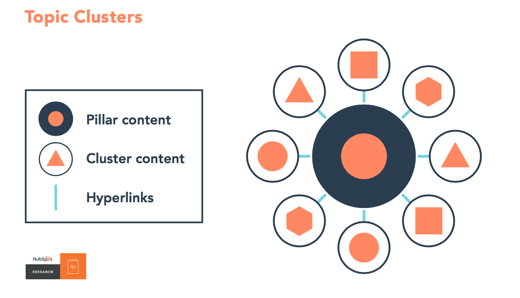
Image source: Hubspot
You can in-depth about topic clusters here: Topic Clusters: The Future of SEO & Content Marketing
Keyword Research
Having said all of the above, you might be thinking keywords aren't as important since we're not writing for crawlers anymore. Wrong; keywords are still important. While algorithms have indeed changed, they still need to know what your content really is about, and more importantly understand the intent behind it.
Once you do, your content needs to revolve around that specific phrase, focusing on answering their question, or providing a solution to their certain need or issue.
Essentially what to look for in this situation is a primary keyword and a set of related secondary keywords that more effectively highlight the searcher's intent, just like our example above “how to bake a chocolate cake” example from before (how – bake – chocolate – cake.) Moreover, this is ideal for search engines, as it allows them to present only relevant content, filtering out irrelevant results.
Together, the intent behind these terms should be the same as that of the person searching and in the content that was created to serve it.
For more reading on keywords, check out this post about evaluating keywords for better SEO.
Enjoy our content? Click the button below to share with your Twitter followers!
Title Tags and Metadescriptions are Still Important
Titles and metadescriptions are very important today, perhaps even more than what they used to be. The main purpose has not changed. They still need to contain the appropriate keywords to let your audience and search engines know what your content is about, but the way they should be formulated has changed.
Looking back, when you were initially taught about creating titles, metadescription, subject lines, etc. one thing always stood out. Make it catchy, make it “clickbaity.” That's why sites like Buzzfeed had such massive engagement. But just like all trendy things, this started to weigh on people.
Audiences today want a title and a metadescription that will offer them value. They want something that will explain in a few words what the content they are about to consume is about, and see if it solves their problem or just wastes their time. So next time you are about to create a title and metadescription for your posts, put yourself in their shoes, and see if you are providing enough information (in a concise manner) to tell your audience (and Google) what your content is about.
Take a step back and think for a moment; if your main concern is to “bake a chocolate cake” what would you be more likely to click on?
- Hundreds of chefs are scratching their heads trying to understand why this cake is so irresistible. Click here to find out it secret!
- How to bake a delicious chocolate cake in less than an hour: a recipe by Rachel Ray
Today’s searches and ranking factors are all based on providing value to your audience. If you can show crawlers and visitors that your content is capable of solving their need or question, then you’re golden.
Technical SEO for Ranking
Technical SEO may sound a bit scary, but in reality it is nothing to be afraid of (some argue that it is even easier than creating content!) If you want your content to rank, it’s important to have low bounce rate, high page views, and of course have visitors spend as much time as possible on your site. These are characteristics of a well optimized page that Google picks up on.
There numerous factors that affect this. Let's look at loading speed, XML sitemaps, and mobile optimization.
XML sitemaps
Simply put, an XML sitemap is just a roadmap of all the important pages on your website. Why is this important? Well just like you would use a map (or in today’s world, navigation) to find your way around an unknown city, your XML sitemap is submitted to Google Search Console, and makes it easier (and quicker) for the search engine bots to navigate and crawl all the essential pages that should be indexed.
Example
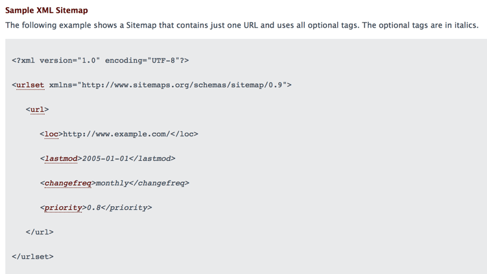
Some XML Sitemap creation hacks to make life a bit easier:
- Different media types (such as video, images, blog posts etc.) should ideally have different sitemaps on your website in order to help make crawling more efficient.
- Don’t go crazy. A sitemap should not exceed 50MB or 50,000 URLs
- Make sure you or coder is using the UTF-8 format for the XML sitemaps.
Page Loading Speed Correlates to SEO Ranking
Have you ever been on a site that just takes forever to load? Chances are, you probably didn't stick around and closed the link.

The loading time of each page plays a major role in today’s SEO and can either make or break your SERPs. Just like you want your content to satisfy user intent, you want your site to provide a pleasant experience. So, the faster a page loads, the more likely your visitors will browse through your content. This also reduces your bounce rate as your audience is less likely to, well…"bounce" off your site.
To check your pages loading speeds, you can use Google’s PageSpeed Insights tool. This tool evaluates your web page speed and mobile page speed, and helps you pinpoint which pages are optimized and which might need some attention.
Note: Google Webmaster Trends Analyst John Mueller recommends you keep your HTTP load speed less than 2 – 3 seconds.
Don’t just rely on tools though. Pretend you are a visitor on your own site and start navigating a few pages. What is the experience like? How does each page feel? Is the load time swift and responsive or does it get aggravating after a short while?
So how can you fix this? The first method is quite easy; simply reduce latency by reorganizing your pages. This way larger, more attention-grabbing content such as images and headers load first, making the rest of the process much easier. The other method is to reduce the HTML to text ratio. This essentially means that there is more stuff running in the background than there is content for visitors to view. If you are not an HTML expert yourself, you might want to seek some help for this one.
Mobile Optimization

Take a look at the image above; what do you see?
Today’s most of us are constantly looking down at a little small screen. Fortunately or unfortunately, depending on your point of view, mobile devices have become a very large part of our everyday lives, and with more and more people browsing the web on their phones or tablets, mobile-optimized websites are a necessity.
You can test if your site is mobile friendly by using this handy little tool by Google. If your site isn’t performing well, reformatting might just be your next priority. This is a very important step and should not be overlooked. A site that is not mobile friendly can lead to a loss of traffic, and can severely hurt your SERPs.
Domain Authority Can Make or Break Your SERPs
How does domain authority possibly affect SEO? Well back to our chocolate cake example, who would you trust more: a well organized, clean website, with clear instructions along with video and images on how to make the perfect cake? Or a site that has 1 paragraph of text, 17 ads, 9 pop-ups, terrible graphics, and looks like it hasn’t been touched since 2002?
The example might be a bit extreme but you get the point.
The better the authority of your page, the greater the chance it will rank well on Google. This shows the search engine that you are reliable, and that you have high-quality content your audience will value.
The pages that rank higher on SERPs usually have a high domain authority. Sites are given a score ranging between 1 and 100.
Despite sounding abstract, domain authority can actually be calculated. Search engines use a combination of referring domains, backlinks, and internal linking into consideration when grading a page’s authority.
Note: The higher the authority score, and the number of quality pages linking back to your site, the better your score. The opposite is also true, so be careful.
For more information on backlinking and building your domain's authority check out the links below:
Link Building Also has a Significant Part to Play in SEO Ranking
It’s not enough to just receive links from other sites; linking to external valuable resources your audience might find beneficial is also great for SEO, and can greatly enhance user experience.
Internal links within your own content can also make your site look more reliable, as it pushes visitors to more relevant content they will find helpful.
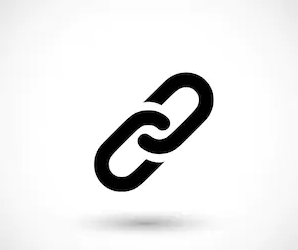
Note: The internal links you choose should favor your most valuable content in the context of user intent. For example, after learning how to bake your cake, you might be interested in glazing techniques, or how to make other similar pastries. It is doubtful that you would care about a link trying to direct you towards, “The best way to descale a fish.”
Keep in mind that links higher up on your page tend to hold more weight than those further down, so try to link your most valuable content accordingly (in the context of your audience’s intent.)
Google also takes the relevance of your links and their anchor text into consideration. You should choose a word that reflects the basic idea of what the page linked to is about. So avoiding generic off-topic anchor text like “click here” or “this article” should be avoided.
How to Factor Video and Media into SEO Ranking
Video and images can work wonders for SEO ranking.
In most cases, infographics, images, and videos show search engines that you are a website with varied forms of high quality, value-driven content. It might not feel like it, but oftentimes, this kind of media is what is most relevant to the searches being made.
Note: These media files should be properly optimized so they can be picked up by crawlers searching your content and pages. Include appropriate titles, ALT descriptions, and captions for the best results, always including the keywords you used in the post featuring the media. It is important you provide as much information as possible so they know what the media is about and to help search engines match your content to relevant searches.
Final Thoughts
SEO is constantly shifting to focus on a user's intent and experience. A perfect example of this is topic clusters dethroning keyword stuffing. When it comes to SEO, remember to be mobile friendly and create content that will provide your audience with the value they are looking for. Just as you browse the web to answer a certain question or satisfy a specific need, your audience is too.
Oh, and one final thing; be patient. Even if you perfectly optimize your website or blog for search engines, remember that you will not see results immediately. SEO takes time. It takes time for crawlers to go through your content, and it takes time for Google to "appraise" and index your pages. So don't be discouraged if you go through all the trouble of perfecting your site's SEO and don't see any immediate benefits.
Do you have any questions? Is there anything you want us to dig deeper in? Let us know!
And as always check out the links below for more digital marketing insight:
- Hitting Bullseye: Evaluating Keywords For Better SEO
- Video SEO: How to Optimize and Increase Traffic to Your Videos
- The Evolution Of Content Marketing: Steps You Can Take To Keep Up
- 5 Marketing Magnets That Drive Lead Generation
- 4 Tactics for a Better LinkedIn Content Strategy
- Twitter Optimization: Creating A Winning Twitter Page
